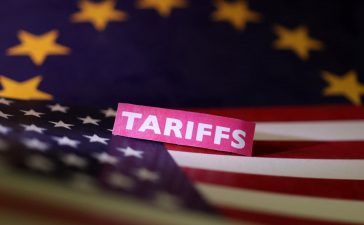Back in a time of cheap capital and plentiful labour, online food delivery companies believed they had a recipe for success. Fast revenue growth caught the eye of investors. A captive market full of consumers working from home increased demand for their services.
After years of breakneck expansion, and with fewer diners stuck at home, the pace of deliveries normalised. Deeply depressed share prices mean that companies such as Just Eat Takeaway (JET), Frankfurt-quoted Delivery Hero and UK-listed Deliveroo must focus on the meat and potatoes of profits.
Consider JET, listed in Amsterdam and London. It reported full-year earnings this week. Its business model leans heavily on big growth, dominating local markets and finding innovative ways to handle orders. For JET, at least, the first tenet has not worked out as planned.
Delivery services such as JET began by offering a marketplace for fast food restaurants to distribute to households. The online platforms offered customers choice. The restaurants cooked and delivered the food.
In recent years, that model has changed. JET has put drivers on the payroll. This gave it better control over logistics, but increased overheads. It aimed to create as large an operation as possible grabbing market share and, it hoped, reducing costs.
JET is the fruit of international takeovers. In 2020, Takeaway of the Netherlands bought the UK’s Just Eat for £6.2bn (€5.7bn). The following year the company acquired Grubhub of the US for $7.3bn (€8.9bn).

Indigestion quickly set in. Grubhub could not keep up with its US rivals DoorDash and Uber Eats, part of the ride-hailing company. A business valued by the market at over €17bn in September 2021 was worth less than a fifth of that just a year later. Shareholders began to complain vociferously about that collapse. JET had to find a way to turn a profit and dispose of Grubhub.
This week, JET’s results confirmed that it has finally begun to generate some positive earnings before interest, tax, depreciation and amortisation (ebitda) in the second half of last year. For the full year a slim €19mn was produced. But it also confirmed that some acquisitions in recent years, especially Grubhub, were overpriced.
JET slashed the value of these assets on its balance sheet using the accounting process of impairment. Companies annually test the valuation of acquired assets. In this case more than €4.5bn was written off, two-thirds of which was for Grubhub. Impairments do pass through the income statement (though do not affect cash flow). These forced JET to report a net loss of €5.7bn.
It seems that scale, at least across international borders, produced no net benefits. Instead, growth by acquisition destroyed value.
Meanwhile there is only limited evidence that JET has benefited from local dominance. In the UK and Ireland, its biggest contributor to revenues, the positive ebitda contribution was small (€23mn), compared with Northern Europe — including Germany and the Netherlands — with nearly 14 times more. Orders, which declined for the whole group, fell a tenth in the UK compared with only 3 per cent in Northern Europe.
Labour costs are rising meanwhile — head office overheads alone rose last year by 6 per cent.

Food delivery groups are now sacrificing growth in favour of earnings. Shares reflect reduced expectations, trading at about one times for JET and Delivery Hero and a fraction of that for Deliveroo.
Lex has been broadly bearish on food delivery businesses for some time. They boast lower network advantages than tech giants such as Facebook and Google. Their costs are higher. And they have a habit of splurging capital on expensive advertising. JET’s recent travails confirm our pessimistic view of the sector.
China lithium: eco probe enables CATL to milk the situation
Beijing is adding lithium mining to its long list of crackdown targets. An official probe into alleged environmental rule breaking has imposed shutdowns on China’s largest mine and production hub, according to local reports. Curiously, this could end up benefiting local electric battery giant CATL.
Lithium provides the ions to carry the charge across the anode and cathode of a battery. Miners in Yichun, Jiangxi province, produce about a tenth of the global supply of lithium.
Coping with crackdowns has become a normal part of doing business in China. Probes and restrictions have spanned the tech, education and property sectors. Harsh scrutiny typically follows share price gains and record earnings.
Global lithium prices hit a record high last year, thanks to surging electric vehicle sales. Ganfeng Lithium, the biggest local specialist, expects preliminary net income for 2022 to rise more than fourfold. Its rival Tianqi Lithium has forecast net income will jump more than 1,100 per cent to above $3.7bn.
Extended shutdowns could hurt these businesses. A couple of years ago, the earnings of battery and electric carmakers would have suffered too. That is no longer universally true.
CATL is the world’s largest manufacturer of electric vehicle batteries and has received strong government support. It supplies nearly 40 per cent of the global market. Its aggressive investments in the lithium sector mean it has access to large amounts of lithium at stable prices. Sources range from Australia and Argentina to Bolivia.
A rise in the cost of lithium from China, which controls two-thirds of world processing capacity, creates a relative advantage for better-hedged companies such as CATL. This should support CATL shares trading at 25 times forward earnings, according to S&P Capital IQ. It should meanwhile prompt the west to question its dependence on China for a mineral that is globally abundant.

Lex is the FT’s concise daily investment column. Expert writers in four global financial centres provide informed, timely opinions on capital trends and big businesses. Click to explore










